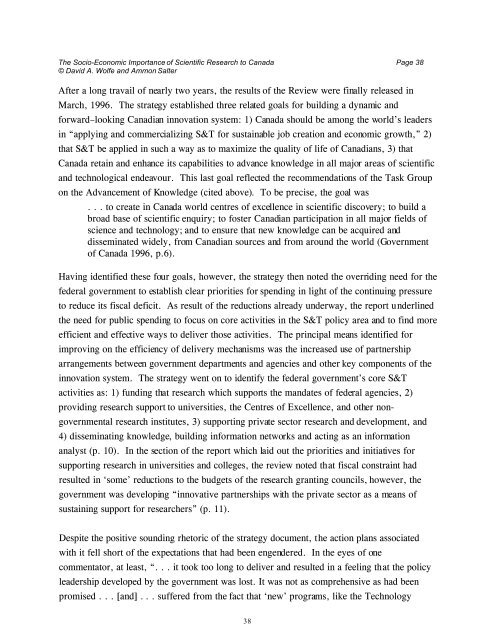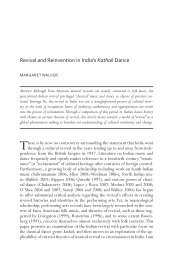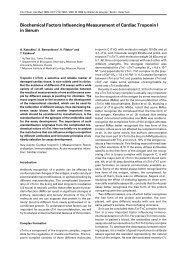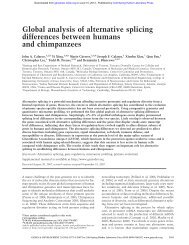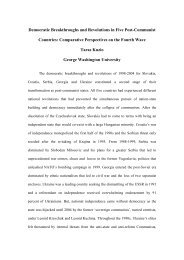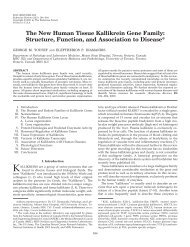The Socio-Economic Importance of Scientific Research To Canada
The Socio-Economic Importance of Scientific Research To Canada
The Socio-Economic Importance of Scientific Research To Canada
You also want an ePaper? Increase the reach of your titles
YUMPU automatically turns print PDFs into web optimized ePapers that Google loves.
<strong>The</strong> <strong>Socio</strong>-<strong>Economic</strong> <strong>Importance</strong> <strong>of</strong> <strong>Scientific</strong> <strong>Research</strong> to <strong>Canada</strong> Page 38© David A. Wolfe and Ammon SalterAfter a long travail <strong>of</strong> nearly two years, the results <strong>of</strong> the Review were finally released inMarch, 1996. <strong>The</strong> strategy established three related goals for building a dynamic andforward–looking Canadian innovation system: 1) <strong>Canada</strong> should be among the world’s leadersin “applying and commercializing S&T for sustainable job creation and economic growth,” 2)that S&T be applied in such a way as to maximize the quality <strong>of</strong> life <strong>of</strong> Canadians, 3) that<strong>Canada</strong> retain and enhance its capabilities to advance knowledge in all major areas <strong>of</strong> scientificand technological endeavour. This last goal reflected the recommendations <strong>of</strong> the Task Groupon the Advancement <strong>of</strong> Knowledge (cited above). <strong>To</strong> be precise, the goal was. . . to create in <strong>Canada</strong> world centres <strong>of</strong> excellence in scientific discovery; to build abroad base <strong>of</strong> scientific enquiry; to foster Canadian participation in all major fields <strong>of</strong>science and technology; and to ensure that new knowledge can be acquired anddisseminated widely, from Canadian sources and from around the world (Government<strong>of</strong> <strong>Canada</strong> 1996, p.6).Having identified these four goals, however, the strategy then noted the overriding need for thefederal government to establish clear priorities for spending in light <strong>of</strong> the continuing pressureto reduce its fiscal deficit. As result <strong>of</strong> the reductions already underway, the report underlinedthe need for public spending to focus on core activities in the S&T policy area and to find moreefficient and effective ways to deliver those activities. <strong>The</strong> principal means identified forimproving on the efficiency <strong>of</strong> delivery mechanisms was the increased use <strong>of</strong> partnershiparrangements between government departments and agencies and other key components <strong>of</strong> theinnovation system. <strong>The</strong> strategy went on to identify the federal government’s core S&Tactivities as: 1) funding that research which supports the mandates <strong>of</strong> federal agencies, 2)providing research support to universities, the Centres <strong>of</strong> Excellence, and other nongovernmentalresearch institutes, 3) supporting private sector research and development, and4) disseminating knowledge, building information networks and acting as an informationanalyst (p. 10). In the section <strong>of</strong> the report which laid out the priorities and initiatives forsupporting research in universities and colleges, the review noted that fiscal constraint hadresulted in ‘some’ reductions to the budgets <strong>of</strong> the research granting councils, however, thegovernment was developing “innovative partnerships with the private sector as a means <strong>of</strong>sustaining support for researchers” (p. 11).Despite the positive sounding rhetoric <strong>of</strong> the strategy document, the action plans associatedwith it fell short <strong>of</strong> the expectations that had been engendered. In the eyes <strong>of</strong> onecommentator, at least, “. . . it took too long to deliver and resulted in a feeling that the policyleadership developed by the government was lost. It was not as comprehensive as had beenpromised . . . [and] . . . suffered from the fact that ‘new’ programs, like the Technology38


